2022 HYUNDAI TUCSON Maintenance
[x] Cancel search: MaintenancePage 588 of 638
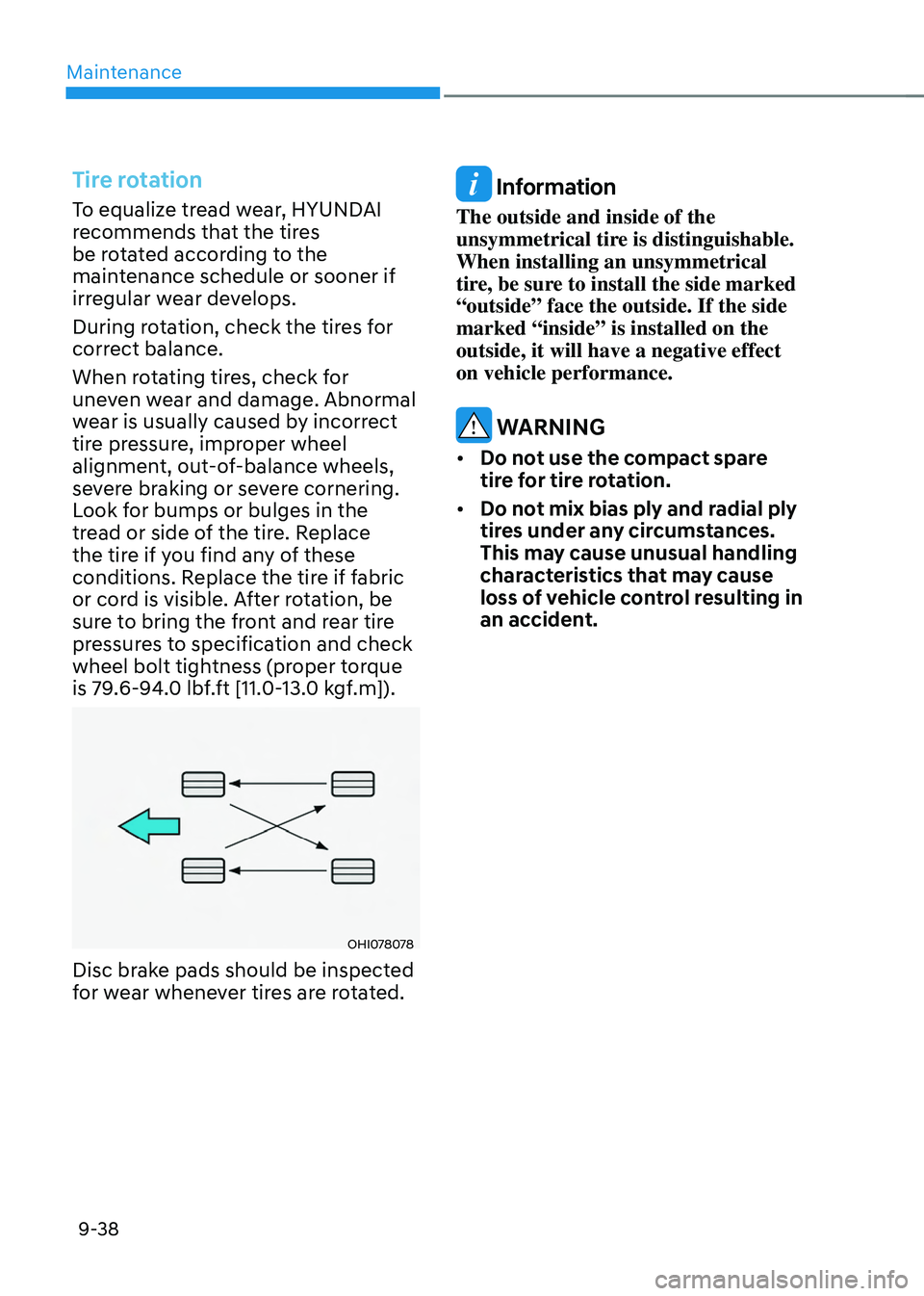
Maintenance
9-38
Tire rotation
To equalize tread wear, HYUNDAI
recommends that the tires
be rotated according to the
maintenance schedule or sooner if
irregular wear develops.
During rotation, check the tires for
correct balance.
When rotating tires, check for
uneven wear and damage. Abnormal
wear is usually caused by incorrect
tire pressure, improper wheel
alignment, out-of-balance wheels,
severe braking or severe cornering.
Look for bumps or bulges in the
tread or side of the tire. Replace
the tire if you find any of these
conditions. Replace the tire if fabric
or cord is visible. After rotation, be
sure to bring the front and rear tire
pressures to specification and check
wheel bolt tightness (proper torque
is 79.6-94.0 lbf.ft [11.0-13.0 kgf.m]).
OHI078078
Disc brake pads should be inspected
for wear whenever tires are rotated.
Information
The outside and inside of the
unsymmetrical tire is distinguishable.
When installing an unsymmetrical
tire, be sure to install the side marked
“outside” face the outside. If the side
marked “inside” is installed on the
outside, it will have a negative effect
on vehicle performance.
WARNING
• Do not use the compact spare
tire for tire rotation.
• Do not mix bias ply and radial ply
tires under any circumstances.
This may cause unusual handling
characteristics that may cause
loss of vehicle control resulting in
an accident.
Page 590 of 638
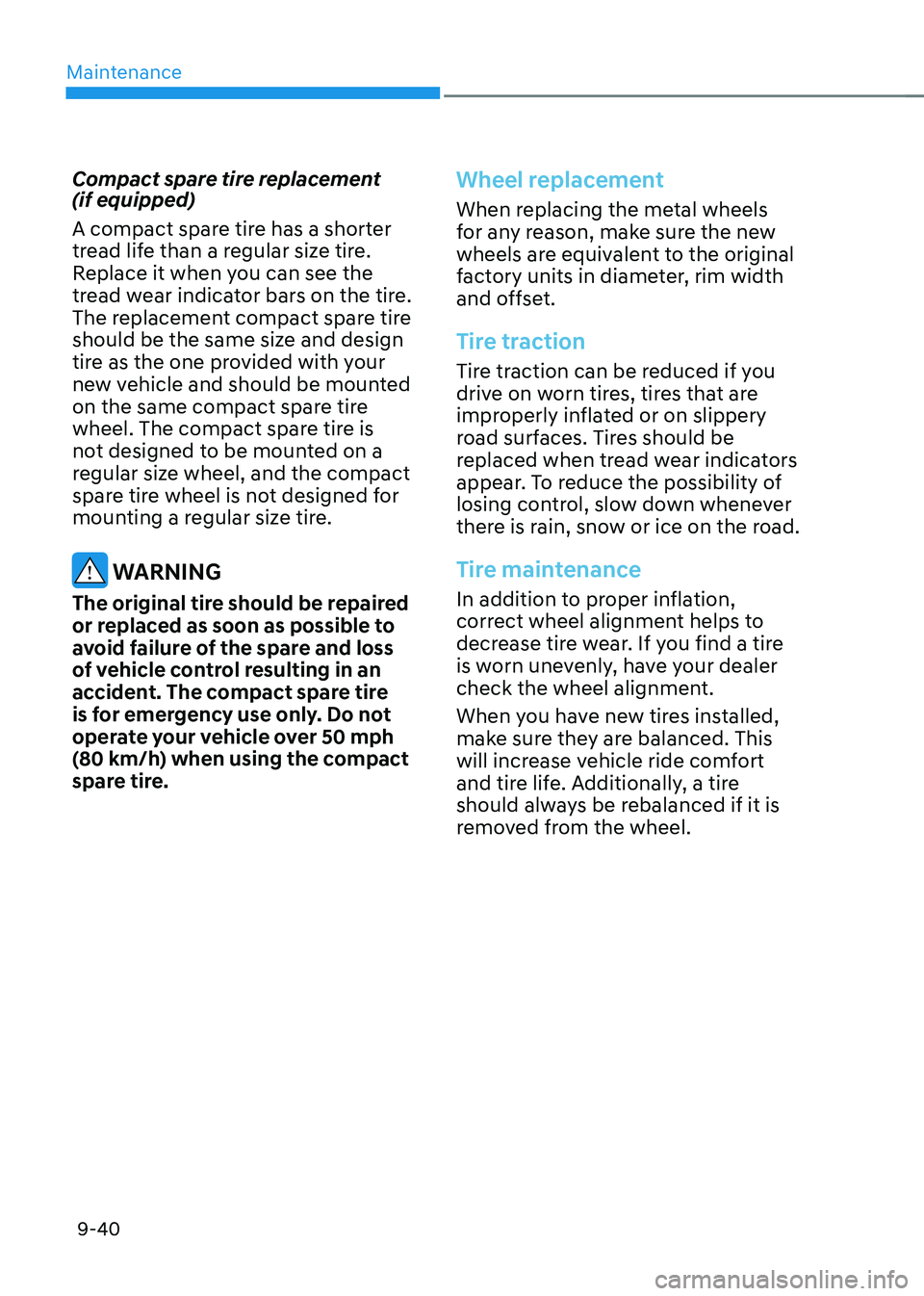
Maintenance
9-40
Compact spare tire replacement
(if equipped)
A compact spare tire has a shorter
tread life than a regular size tire.
Replace it when you can see the
tread wear indicator bars on the tire.
The replacement compact spare tire
should be the same size and design
tire as the one provided with your
new vehicle and should be mounted
on the same compact spare tire
wheel. The compact spare tire is
not designed to be mounted on a
regular size wheel, and the compact
spare tire wheel is not designed for
mounting a regular size tire.
WARNING
The original tire should be repaired
or replaced as soon as possible to
avoid failure of the spare and loss
of vehicle control resulting in an
accident. The compact spare tire
is for emergency use only. Do not
operate your vehicle over 50 mph
(80 km/h) when using the compact
spare tire.
Wheel replacement
When replacing the metal wheels
for any reason, make sure the new
wheels are equivalent to the original
factory units in diameter, rim width
and offset.
Tire traction
Tire traction can be reduced if you
drive on worn tires, tires that are
improperly inflated or on slippery
road surfaces. Tires should be
replaced when tread wear indicators
appear. To reduce the possibility of
losing control, slow down whenever
there is rain, snow or ice on the road.
Tire maintenance
In addition to proper inflation,
correct wheel alignment helps to
decrease tire wear. If you find a tire
is worn unevenly, have your dealer
check the wheel alignment.
When you have new tires installed,
make sure they are balanced. This
will increase vehicle ride comfort
and tire life. Additionally, a tire
should always be rebalanced if it is
removed from the wheel.
Page 592 of 638
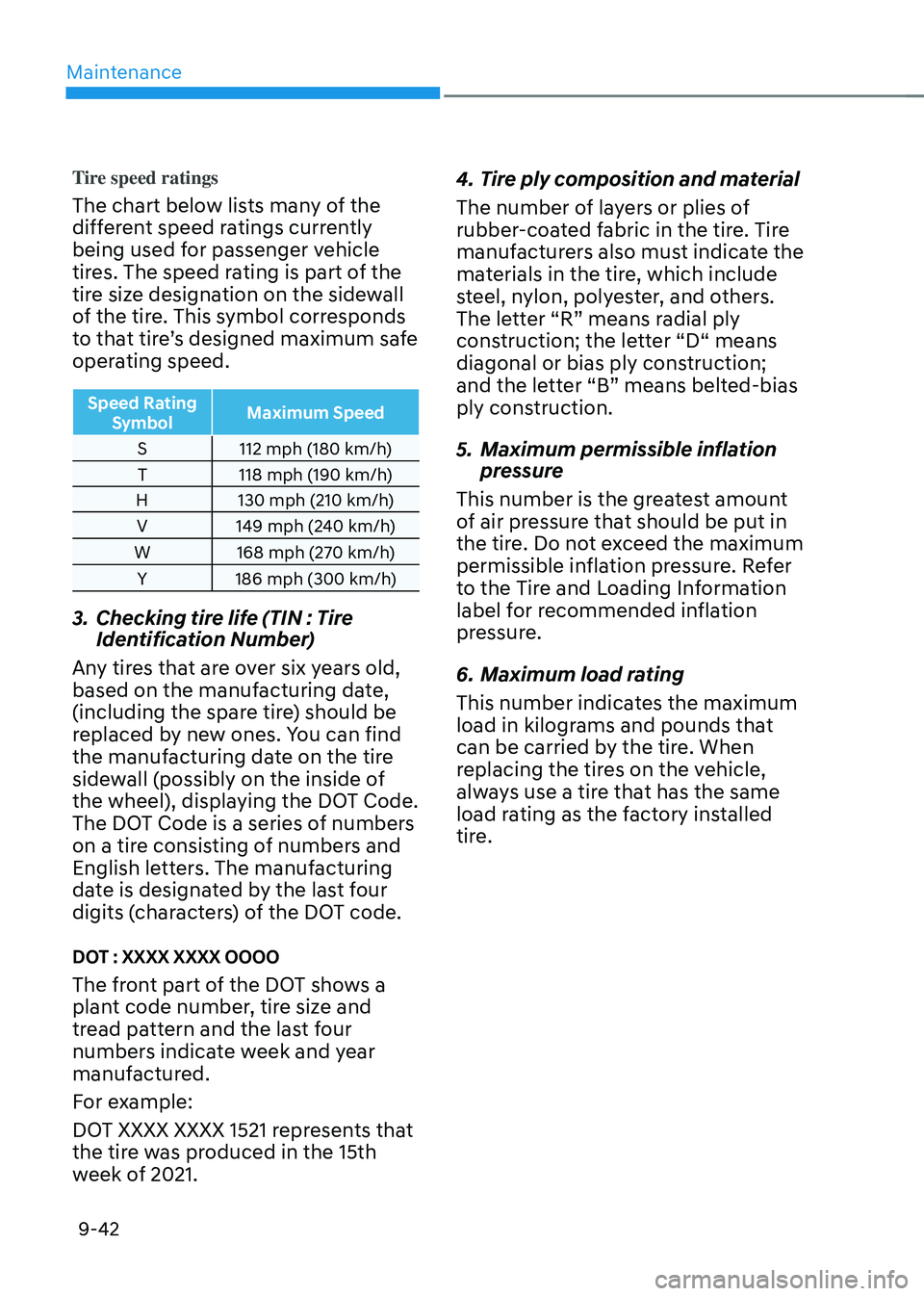
Maintenance
9-42
Tire speed ratings
The chart below lists many of the
different speed ratings currently
being used for passenger vehicle
tires. The speed rating is part of the
tire size designation on the sidewall
of the tire. This symbol corresponds
to that tire’s designed maximum safe
operating speed.
Speed Rating Symbol Maximum Speed
S 112 mph (180 km/h)
T 118 mph (190 km/h)
H 130 mph (210 km/h)
V 149 mph (240 km/h)
W 168 mph (270 km/h)
Y 186 mph (300 km/h)
3. Checking tire life (TIN : Tire
Identification Number)
Any tires that are over six years old,
based on the manufacturing date,
(including the spare tire) should be
replaced by new ones. You can find
the manufacturing date on the tire
sidewall (possibly on the inside of
the wheel), displaying the DOT Code.
The DOT Code is a series of numbers
on a tire consisting of numbers and
English letters. The manufacturing
date is designated by the last four
digits (characters) of the DOT code.
DOT : XXXX XXXX OOOO
The front part of the DOT shows a
plant code number, tire size and
tread pattern and the last four
numbers indicate week and year
manufactured.
For example:
DOT XXXX XXXX 1521 represents that
the tire was produced in the 15th
week of 2021.
4. Tire ply composition and material
The number of layers or plies of
rubber-coated fabric in the tire. Tire
manufacturers also must indicate the
materials in the tire, which include
steel, nylon, polyester, and others.
The letter “R” means radial ply
construction; the letter “D“ means
diagonal or bias ply construction;
and the letter “B” means belted-bias
ply construction.
5. Maximum permissible inflation
pressure
This number is the greatest amount
of air pressure that should be put in
the tire. Do not exceed the maximum
permissible inflation pressure. Refer
to the Tire and Loading Information
label for recommended inflation
pressure.
6. Maximum load rating
This number indicates the maximum
load in kilograms and pounds that
can be carried by the tire. When
replacing the tires on the vehicle,
always use a tire that has the same
load rating as the factory installed
tire.
Page 594 of 638
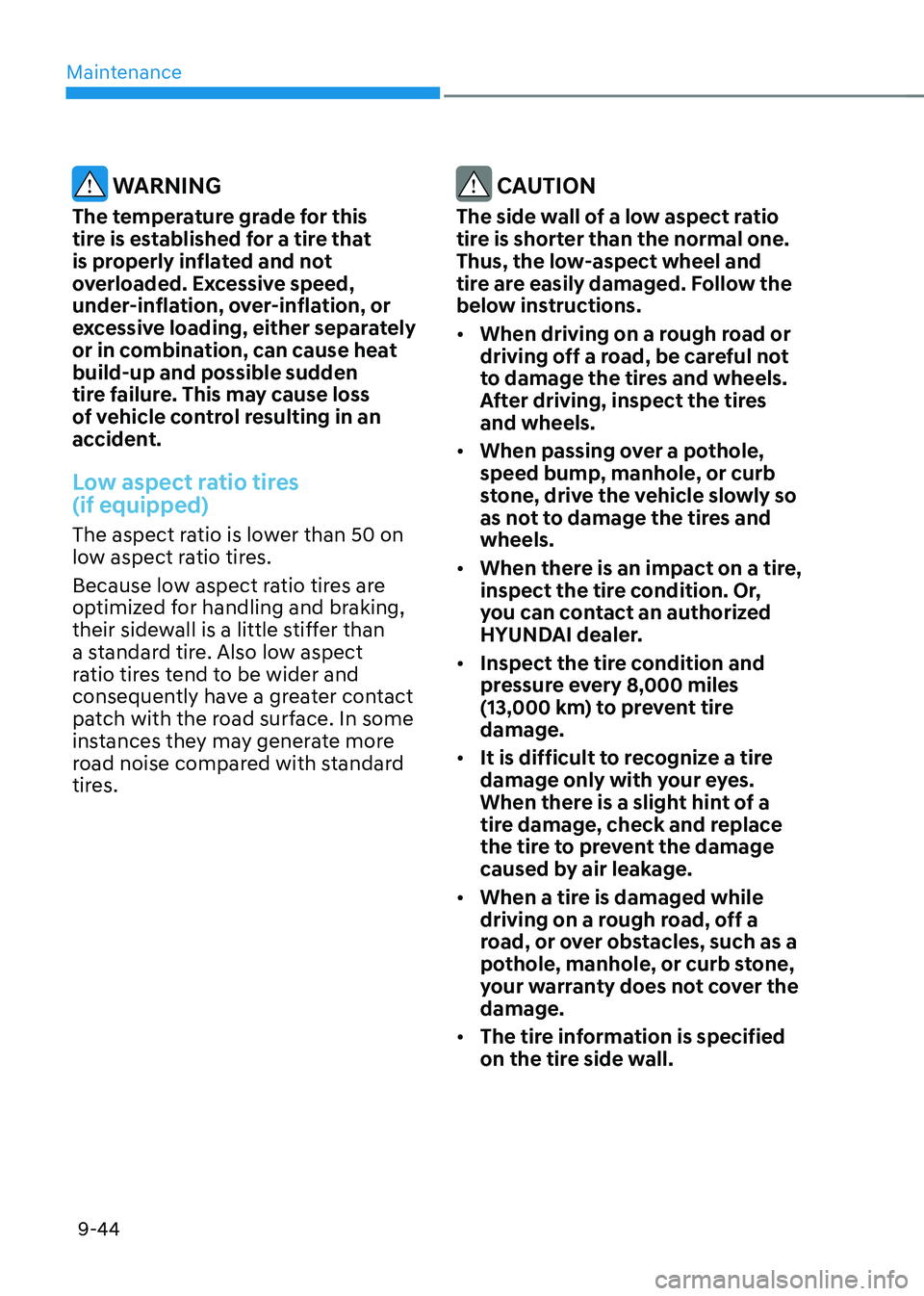
Maintenance
9-44
WARNING
The temperature grade for this
tire is established for a tire that
is properly inflated and not
overloaded. Excessive speed,
under-inflation, over-inflation, or
excessive loading, either separately
or in combination, can cause heat
build-up and possible sudden
tire failure. This may cause loss
of vehicle control resulting in an
accident.
Low aspect ratio tires
(if equipped)
The aspect ratio is lower than 50 on
low aspect ratio tires.
Because low aspect ratio tires are
optimized for handling and braking,
their sidewall is a little stiffer than
a standard tire. Also low aspect
ratio tires tend to be wider and
consequently have a greater contact
patch with the road surface. In some
instances they may generate more
road noise compared with standard
tires.
CAUTION
The side wall of a low aspect ratio
tire is shorter than the normal one.
Thus, the low-aspect wheel and
tire are easily damaged. Follow the
below instructions.
• When driving on a rough road or
driving off a road, be careful not
to damage the tires and wheels.
After driving, inspect the tires
and wheels.
• When passing over a pothole,
speed bump, manhole, or curb
stone, drive the vehicle slowly so
as not to damage the tires and
wheels.
• When there is an impact on a tire,
inspect the tire condition. Or,
you can contact an authorized
HYUNDAI dealer.
• Inspect the tire condition and
pressure every 8,000 miles
(13,000 km) to prevent tire
damage.
• It is difficult to recognize a tire
damage only with your eyes.
When there is a slight hint of a
tire damage, check and replace
the tire to prevent the damage
caused by air leakage.
• When a tire is damaged while
driving on a rough road, off a
road, or over obstacles, such as a
pothole, manhole, or curb stone,
your warranty does not cover the
damage.
• The tire information is specified
on the tire side wall.
Page 596 of 638
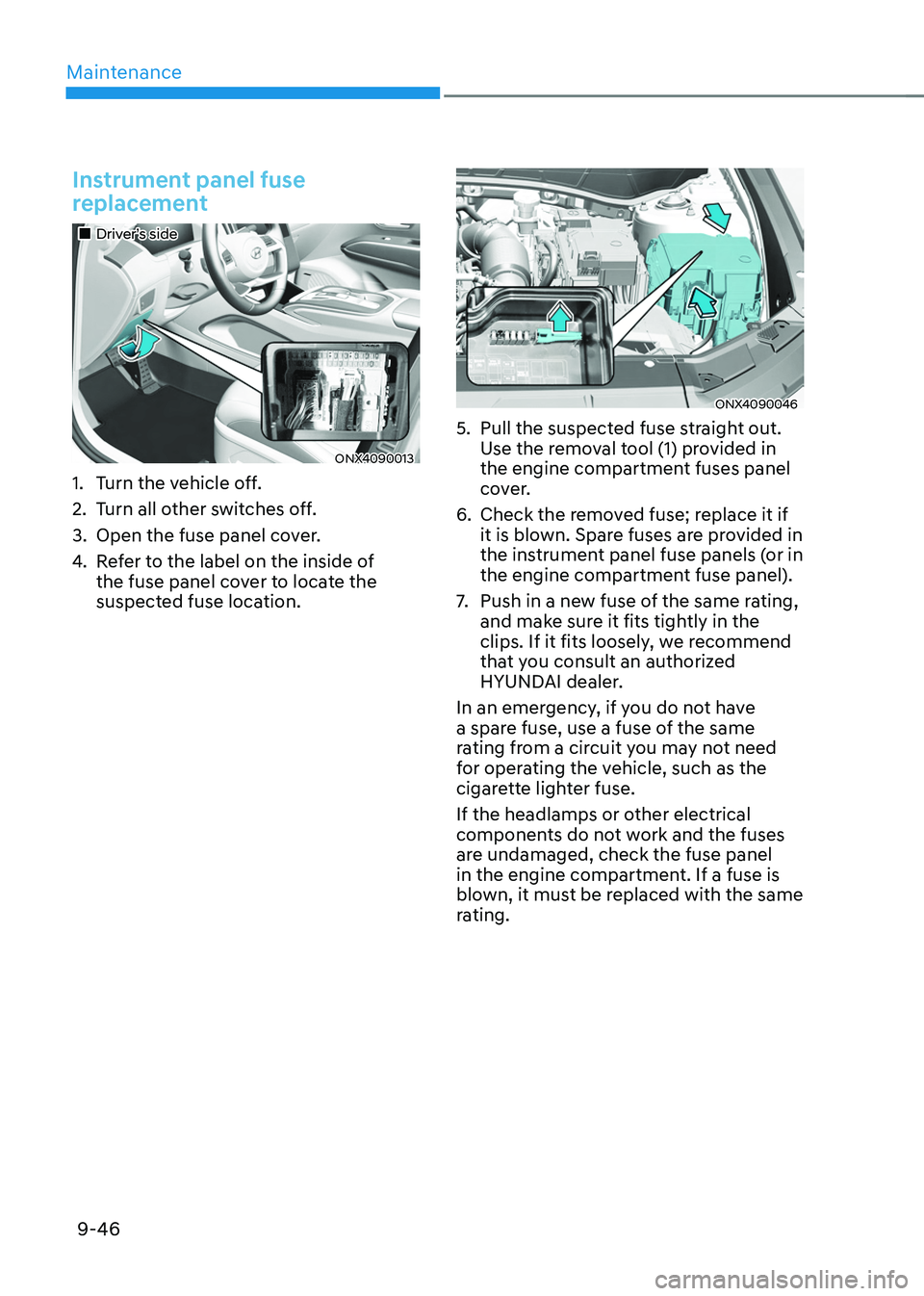
Maintenance
9-46
Instrument panel fuse
replacement
„„Driver’s side
ONX4090013
1. Turn the vehicle off.
2. Turn all other switches off.
3. Open the fuse panel cover.
4. Refer to the label on the inside of
the fuse panel cover to locate the
suspected fuse location.
ONX4090046
5. Pull the suspected fuse straight out.
Use the removal tool (1) provided in
the engine compartment fuses panel
cover.
6. Check the removed fuse; replace it if
it is blown. Spare fuses are provided in
the instrument panel fuse panels (or in
the engine compartment fuse panel).
7. Push in a new fuse of the same rating,
and make sure it fits tightly in the
clips. If it fits loosely, we recommend
that you consult an authorized
HYUNDAI dealer.
In an emergency, if you do not have
a spare fuse, use a fuse of the same
rating from a circuit you may not need
for operating the vehicle, such as the
cigarette lighter fuse.
If the headlamps or other electrical
components do not work and the fuses
are undamaged, check the fuse panel
in the engine compartment. If a fuse is
blown, it must be replaced with the same
rating.
Page 598 of 638
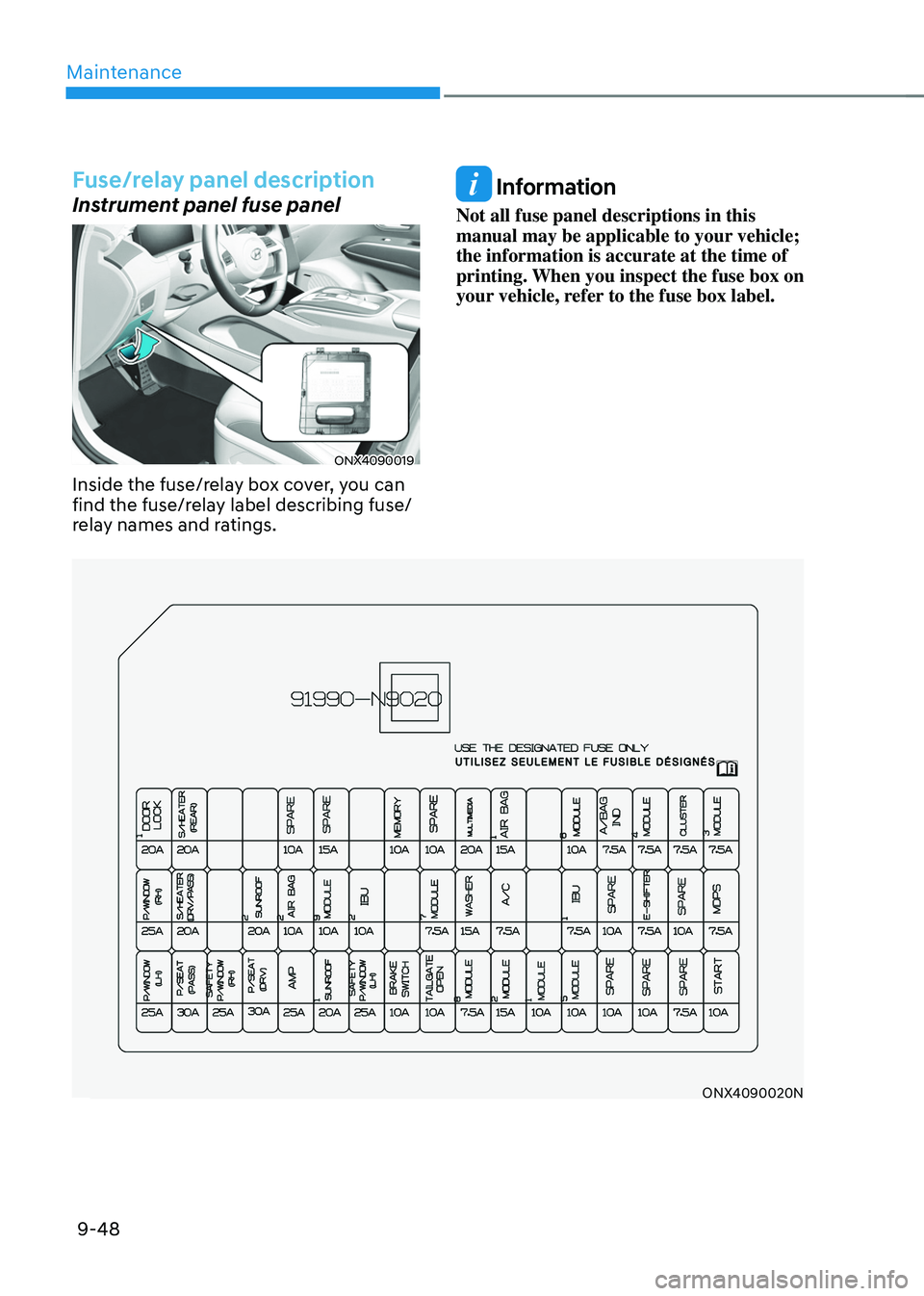
Maintenance
9-48
Fuse/relay panel description
Instrument panel fuse panel
ONX4090019
Inside the fuse/relay box cover, you can
find the fuse/relay label describing fuse/
relay names and ratings.
Information
Not all fuse panel descriptions in this
manual may be applicable to your vehicle;
the information is accurate at the time of
printing. When you inspect the fuse box on
your vehicle, refer to the fuse box label.
ONX4090020N
Page 600 of 638
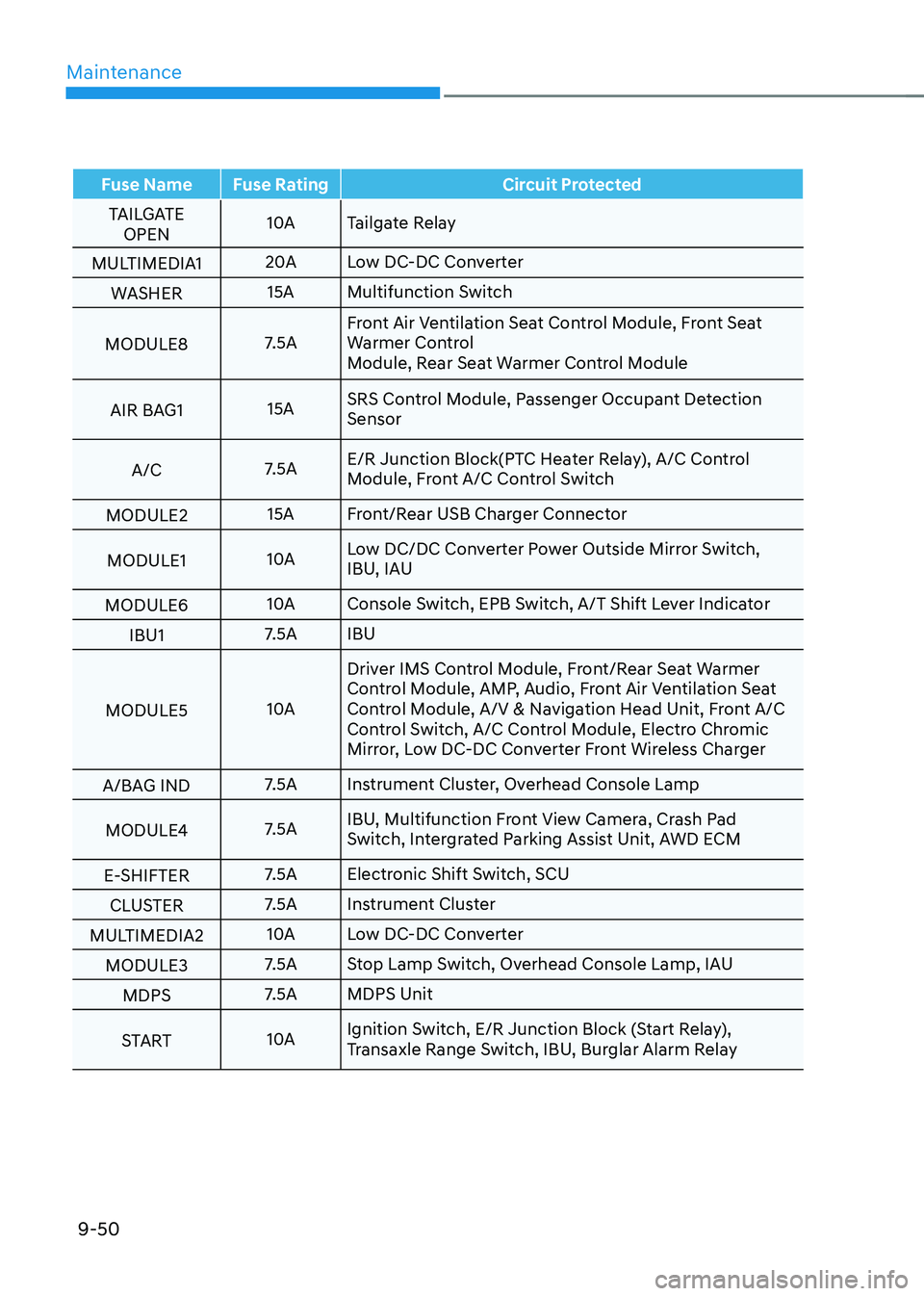
Maintenance
9-50
Fuse NameFuse Rating Circuit Protected
TAILGATE OPEN 10A
Tailgate Relay
MULTIMEDIA1 20A
Low DC-DC Converter
WASHER 15A
Multifunction Switch
MODULE8 7.5AFront Air Ventilation Seat Control Module, Front Seat
Warmer Control
Module, Rear Seat Warmer Control Module
AIR BAG1 15ASRS Control Module, Passenger Occupant Detection
Sensor
A/C 7.5AE/R Junction Block(PTC Heater Relay), A/C Control
Module, Front A/C Control Switch
MODULE2 15A
Front/Rear USB Charger Connector
MODULE1 10ALow DC/DC Converter Power Outside Mirror Switch,
IBU, IAU
MODULE6 10A
Console Switch, EPB Switch, A/T Shift Lever Indicator
IBU1 7.5A
IBU
MODULE5 10ADriver IMS Control Module, Front/Rear Seat Warmer
Control Module, AMP, Audio, Front Air Ventilation Seat
Control Module, A/V & Navigation Head Unit, Front A/C
Control Switch, A/C Control Module, Electro Chromic
Mirror, Low DC-DC Converter Front Wireless Charger
A/BAG IND 7.5A
Instrument Cluster, Overhead Console Lamp
MODULE4 7.5AIBU, Multifunction Front View Camera, Crash Pad
Switch, Intergrated Parking Assist Unit, AWD ECM
E-SHIFTER 7.5A
Electronic Shift Switch, SCU
CLUSTER 7.5A
Instrument Cluster
MULTIMEDIA2 10A
Low DC-DC Converter
MODULE3 7.5A
Stop Lamp Switch, Overhead Console Lamp, IAU
MDPS 7.5A
MDPS Unit
START 10AIgnition Switch, E/R Junction Block (Start Relay),
Transaxle Range Switch, IBU, Burglar Alarm Relay
Page 602 of 638
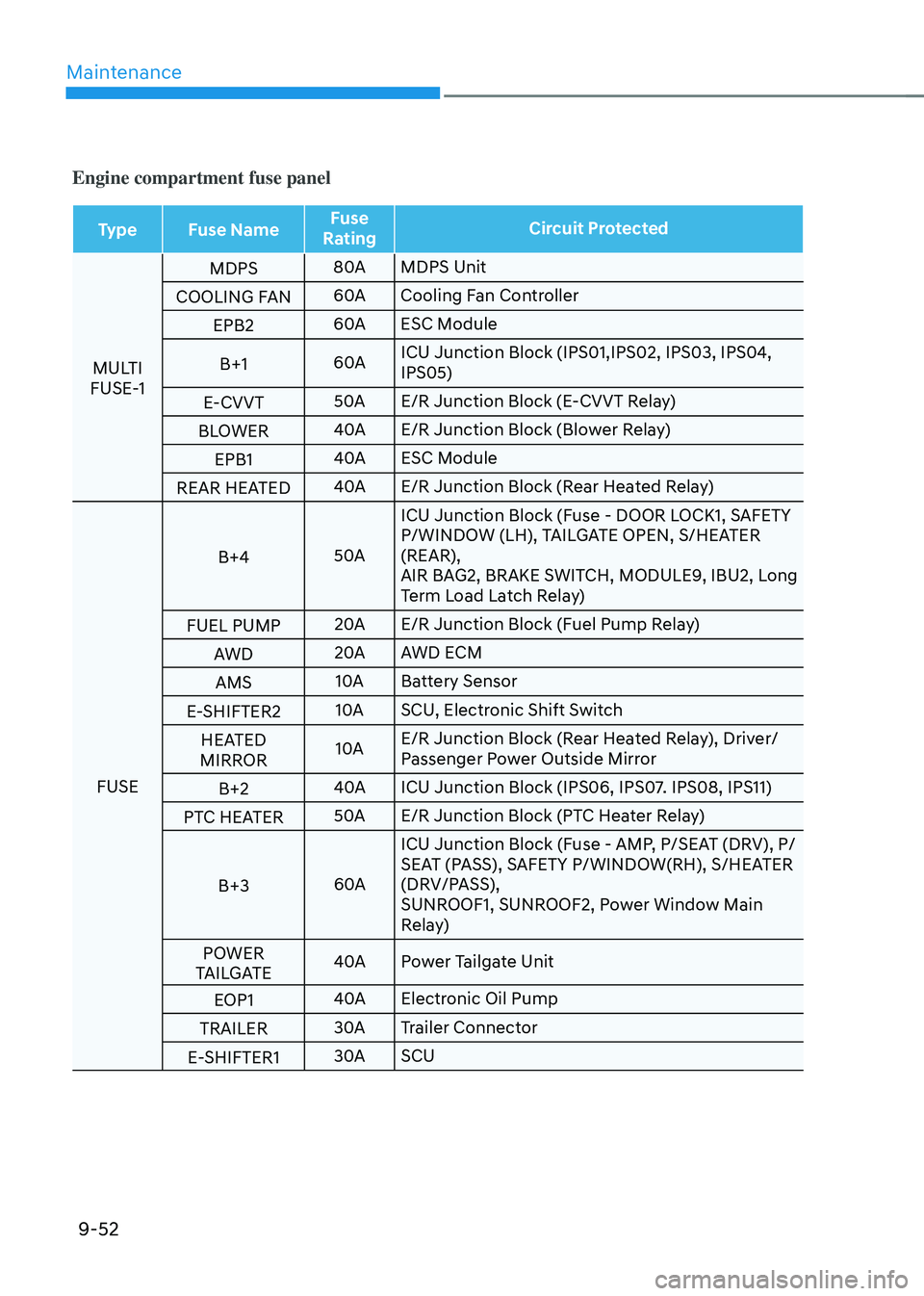
Maintenance
9-52
Engine compartment fuse panel
TypeFuse Name Fuse
Rating Circuit Protected
MULTI
FUSE-1 MDPS
80A
MDPS Unit
COOLING FAN 60A
Cooling Fan Controller
EPB2 60A
ESC Module
B+1 60AICU Junction Block (IPS01,IPS02, IPS03, IPS04,
IPS05)
E-CVVT 50A
E/R Junction Block (E-CVVT Relay)
BLOWER 40A
E/R Junction Block (Blower Relay)
EPB1 40A
ESC Module
REAR HEATED 40A
E/R Junction Block (Rear Heated Relay)
FUSE B+4
50AICU Junction Block (Fuse - DOOR LOCK1, SAFETY
P/WINDOW (LH), TAILGATE OPEN, S/HEATER
(REAR),
AIR BAG2, BRAKE SWITCH, MODULE9, IBU2, Long
Term Load Latch Relay)
FUEL PUMP 20A
E/R Junction Block (Fuel Pump Relay)
AWD 20A
AWD ECM
AMS 10A
Battery Sensor
E-SHIFTER2 10A
SCU, Electronic Shift Switch
HEATED
MIRROR 10A
E/R Junction Block (Rear Heated Relay), Driver/
Passenger Power Outside Mirror
B+2 40A
ICU Junction Block (IPS06, IPS07. IPS08, IPS11)
PTC HEATER 50A
E/R Junction Block (PTC Heater Relay)
B+3 60AICU Junction Block (Fuse - AMP, P/SEAT (DRV), P/
SEAT (PASS), SAFETY P/WINDOW(RH), S/HEATER
(DRV/PASS),
SUNROOF1, SUNROOF2, Power Window Main
Relay)
POWER
TAILGATE 40A
Power Tailgate Unit
EOP1 40A
Electronic Oil Pump
TRAILER 30A
Trailer Connector
E-SHIFTER1 30A
SCU